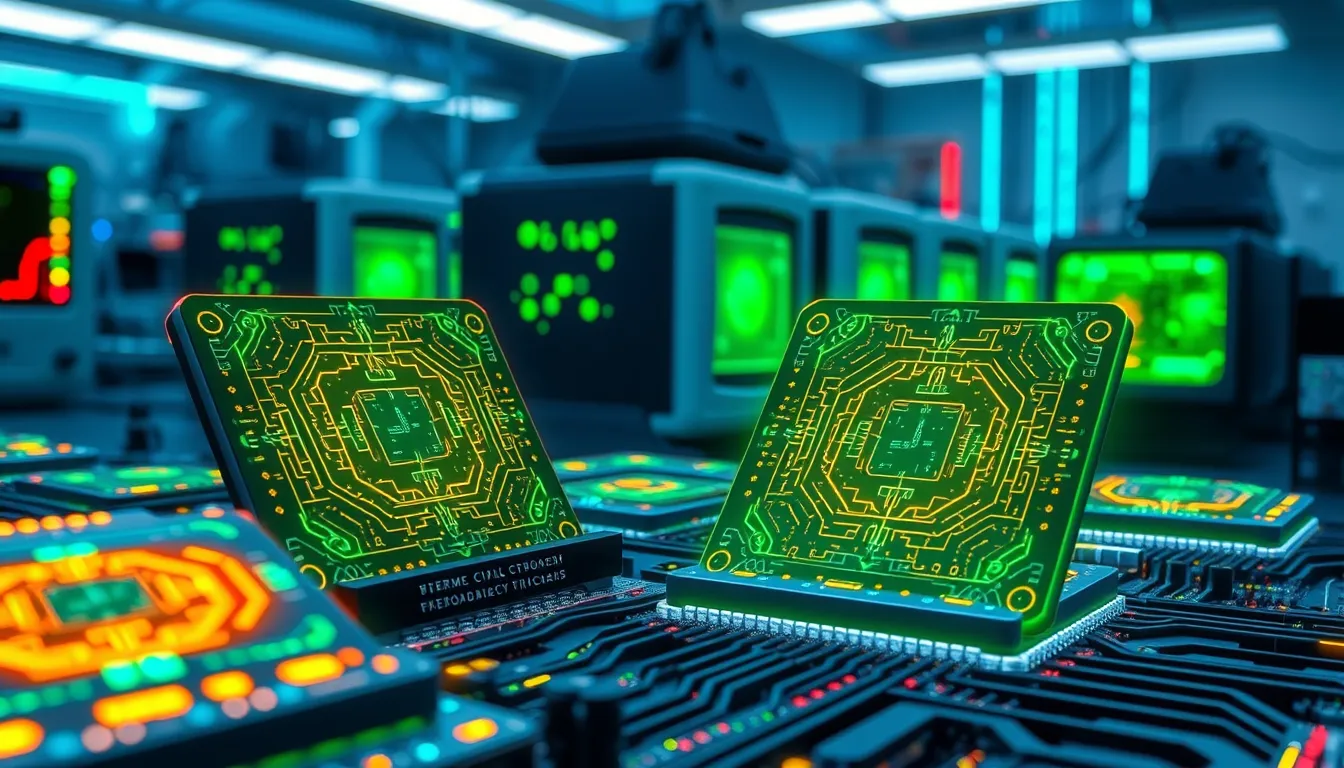Now Reading: Innovative Thermodynamic Computing: Advancing Computation
-
01
Innovative Thermodynamic Computing: Advancing Computation
Innovative Thermodynamic Computing: Advancing Computation

Innovative Thermodynamic Computing: Advancing Computation
Introduction
Thermodynamic computing is emerging as a groundbreaking advancement in the field of computational technology. This innovative approach leverages deep principles from physics to enhance the way we process information, offering potential improvements over classical computing systems. As research into this area progresses, thermodynamic computing promises to push the boundaries of what's feasible, both in terms of processing speed and energy efficiency. In this article, we will explore the science behind thermodynamic computing, its advantages over traditional computing paradigms, and its potential impact across various industries.
Understanding Thermodynamic Computing Technology
Thermodynamic computing represents a radical shift from conventional computing methods by integrating principles of thermodynamics – the branch of physics that deals with heat, energy, and work – into computational processes. Rather than relying solely on electronic switches, as in classical digital computers, thermodynamic computing harnesses natural physical processes to perform calculations. Key aspects of this emerging technology include:
- Harnessing physical processes for computation
- Improving energy efficiency compared to traditional systems
- Providing a robust platform for advanced computational solutions
The Scientific Foundation
At the heart of thermodynamic computing lies the concept that physical systems can process information through state transitions governed by thermodynamic laws. For instance, processes that involve the flow of heat or the relaxation of energy differences can be employed to perform logical operations. This approach is guided by principles such as Landauer's limit, which connects the minimum energy required for processing information to the dissipative nature of physical systems. By carefully managing these thermodynamic transitions, researchers aim to design systems that perform computation with unparalleled efficiency.
Physics and Computation
To appreciate how thermodynamic computing works, it is useful to consider its roots in the classical laws of thermodynamics. In traditional computing, binary logic and semiconductor materials dominate the landscape. However, these systems ultimately face limitations imposed by thermal inefficiencies and heat dissipation. Thermodynamic computing turns this challenge on its head by making use of entropy, energy exchange, and statistical mechanics as computational resources. In effect, these devices are designed to make computation an organic extension of natural physical processes.
How Thermodynamic Computing Surpasses Classical Computing
One of the most compelling aspects of thermodynamic computing is its potential to exceed the performance of classical computing systems. Here are some of the key benefits and directions in which this technology is headed:
1. Enhanced Processing Speeds
Thermodynamic computing has the potential to enable dramatically faster processing speeds. By utilizing physical processes that occur at extremely rapid timescales, these systems could achieve computational speeds that far outpace those of conventional silicon-based circuits. The inherent parallelism in many thermodynamic processes means that multiple operations can occur simultaneously, offering a significant boost in overall throughput. For applications in artificial intelligence, large-scale data analytics, and real-time simulation, this increased speed is a game changer.
2. Superior Energy Efficiency
Energy consumption is a critical concern in modern computing. As classical computing systems continue to shrink in size, managing the dissipated heat becomes increasingly challenging. Thermodynamic computing offers a promising solution by operating closer to fundamental physical limits. By harnessing natural energy flows and minimizing wasteful energy dissipation, these systems can operate with a fraction of the energy normally required by traditional computers. This improvement is not only beneficial for reducing operational costs but is also crucial for environmental sustainability.
3. Enabling New Architectures and Applications
Thermodynamic computing opens the door to novel computational architectures that could revolutionize the design of future processors. Unlike classical computing, which is bound by binary logic, these systems allow for a broader range of computational modes, including probabilistic, reversible, and even quantum-inspired processes. This flexibility paves the way for advanced problem-solving in fields ranging from cryptography to complex optimization problems. Through innovative design approaches, thermodynamic computing can adapt to various application needs, making it an attractive option for next-generation technologies.
Deep Dive into Thermodynamic Principles
To fully understand the promise of thermodynamic computing, it is essential to delve deeper into the underlying principles.
Entropy and Information
In thermodynamics, entropy is a measure of disorder or randomness in a system. In the context of computation, the interplay between entropy and information processing is of critical importance. Traditional computing often fights against entropy by using cooling systems and error correction. In contrast, thermodynamic computing cleverly uses the natural entropy present in physical systems to facilitate computation, effectively turning a classical limitation into a powerful asset.
For example, by designing circuits that naturally settle into low-energy configurations, it is possible to perform computations in a way that is both stable and efficient. This concept is closely related to the idea of reversible computing, where operations can be undone without expending significant additional energy, thus operating near the theoretical minimum energy threshold.
Non-Equilibrium Dynamics
Another cornerstone of thermodynamic computing is the exploitation of non-equilibrium dynamics. In many natural processes, systems are not in thermal equilibrium, meaning that energy flows are uneven or momentarily disordered. By tailoring these processes, researchers can induce specific computational outcomes. These dynamic systems can be manipulated to converge towards a solution through natural physical evolutions, which contrasts sharply with the step-by-step nature of classical algorithms. This approach not only promises efficiency in energy use but also provides a new dimension of computational creativity by harnessing natural phenomena.
The Role of Phase Transitions
Phase transitions, the same phenomena seen when water turns to ice or steam, can also play a significant role in thermodynamic computing. At critical points during a phase transition, the properties of a material can change dramatically over short periods. These transitions can be harnessed to perform binary operations or to switch states in a controlled manner. By setting up systems that exploit these natural transitions, engineers can create devices that operate more fluidly and respond faster than traditional semiconductors. This is particularly relevant for systems where speed and the ability to scale rapidly are paramount.
Overcoming Challenges and Future Outlook
While thermodynamic computing holds significant promise, it also faces a range of challenges that researchers are actively working to address. Understanding and controlling the complex physical processes involved requires interdisciplinary collaboration between computer scientists, physicists, and engineers.
Technical Hurdles
One of the main hurdles in developing thermodynamic computing systems is achieving the necessary precision in controlling physical processes at very small scales. Unlike classical electronic circuits, which have decades of research and optimization behind them, thermodynamic computing is still in its infancy. Engineers must contend with issues such as noise, error propagation, and stability over time. Developing robust error correction methods and reliable ways to harness non-equilibrium dynamics is key to the success of this technology.
Integration with Existing Technologies
Another crucial challenge lies in integrating thermodynamic computing with existing computational frameworks. For the technology to be widely adopted, it must be able to interface with classical computing systems and support standard programming paradigms. Hybrid systems that combine the strengths of both approaches are currently an area of intense research. The goal is to design architectures where thermodynamic components handle high-speed, energy-efficient computations, while traditional processors manage control and general-purpose tasks.
Research and Development Efforts
Many research institutions and technology companies are now investing heavily in exploring the possibilities of thermodynamic computing. Breakthroughs in material science, nanoscale engineering, and theoretical physics are converging to support the development of practical prototypes. Research labs worldwide are experimenting with various designs, from quantum-inspired heat engines to molecular-scale computing devices. These efforts are paving the way for the next generation of computational technology, one that could redefine the limits of processor performance and energy efficiency.
Practical Applications and Industry Impact
Given its potential to revolutionize computation, thermodynamic computing is likely to have a profound impact across multiple industries. Some of the most promising areas of application include:
Artificial Intelligence and Machine Learning
AI and machine learning algorithms require incredibly fast processing and massive amounts of energy, particularly as datasets continue to grow exponentially. Thermodynamic computing could offer a more energy-efficient and speedy alternative that allows AI systems to process complex data sets in real time. This could lead to more advanced neural networks, enhanced pattern recognition capabilities, and overall improvements in machine learning performance.
Big Data and Cloud Computing
For industries reliant on big data, the promise of rapid, energy-efficient processing is extremely appealing. Data centers, which are notorious for their high energy consumption and cooling demands, could benefit from thermodynamic computing by reducing their energy footprint and operational costs. This advancement could revolutionize cloud computing services by enabling faster data processing and more sustainable infrastructures.
Scientific Research and Simulations
Large-scale simulations, such as those used in climate modeling, physics experiments, or financial forecasting, demand significant processing power. Thermodynamic computing systems, with their potential for enhanced speed and efficiency, could dramatically accelerate these simulations, leading to quicker insights and a better understanding of complex systems. This might also open up new avenues in research where computational limitations had previously constrained progress.
Healthcare and Bioinformatics
In the realm of healthcare, the rapid and precise processing of biological data is crucial for advancements in personalized medicine and diagnostic tools. Thermodynamic computing could provide the necessary computational power to analyze vast amounts of genetic and imaging data with high precision, thereby improving patient outcomes and facilitating innovative treatment strategies.
Future Prospects and the Road Ahead
The journey toward fully realizing thermodynamic computing is an exciting one, filled with both significant challenges and revolutionary opportunities. As scientists continue to explore the intricacies of this technology, we can expect to see incremental breakthroughs that steadily transform theoretical concepts into practical applications.
In the near future, hybrid systems that integrate thermodynamic computing with classical architectures are likely to emerge, combining the best of both worlds. These systems will harness the strengths of thermodynamic processes—speed and energy efficiency—while relying on the maturity and stability of traditional semiconductor technologies for overall system management.
Long-term, thermodynamic computing might even catalyze the development of entirely new computational paradigms. As our understanding deepens, we could conceive devices that operate on principles previously thought to be the domain of pure physics research. The cross-pollination of ideas from thermodynamics, quantum mechanics, and information theory promises to unlock computational capabilities that extend far beyond current limitations.
Conclusion
Thermodynamic computing is poised to redefine the very nature of advanced computation. By leveraging the natural laws of physics, this emerging technology offers a promising route to overcome the energy efficiency and speed limitations inherent in classical computing systems. Although still in its early stages, the progress made in understanding and harnessing thermodynamic processes for computation is both impressive and inspiring.
The potential applications of thermodynamic computing are vast, spanning fields such as artificial intelligence, big data analytics, scientific simulations, and healthcare. As research efforts continue to address current technical challenges and integration issues, we can expect thermodynamic computing to play a pivotal role in the next wave of technological innovation.
As industries and research communities worldwide monitor these developments with keen interest, one thing is clear: the future of computation is evolving, and thermodynamic computing is at the forefront of this transformation. Stay tuned for further updates on how this paradigm-shifting approach will redefine the landscape of advanced computation and open up new frontiers in technology.
In summary, thermodynamic computing merges the fundamental concepts of physics with cutting-edge computational technologies, creating opportunities for faster, more energy-efficient processing that could dramatically alter our technological future. As we look towards a world increasingly defined by the integration of advanced computational methods and physical sciences, thermodynamic computing stands as a testament to human ingenuity and our relentless pursuit of knowledge and efficiency in solving complex problems.
With continued research and innovative breakthroughs, the promise of thermodynamic computing may soon become a central pillar of future computational architectures, bringing about an era of unprecedented technological progress.

























